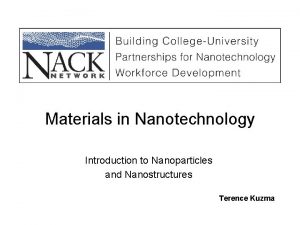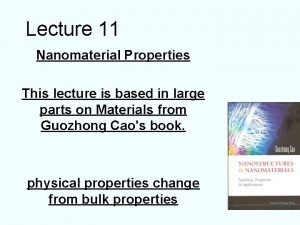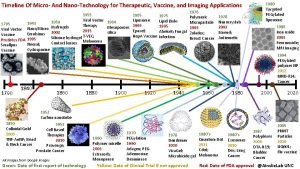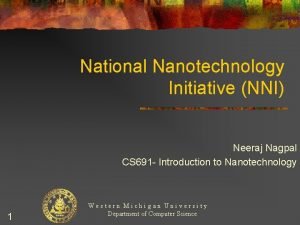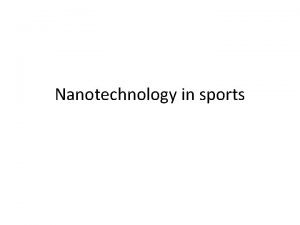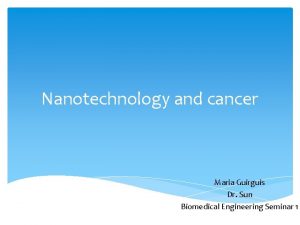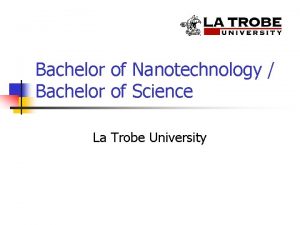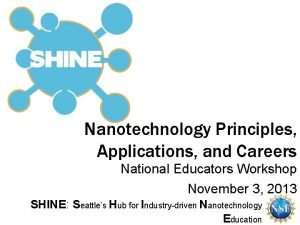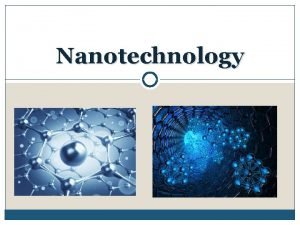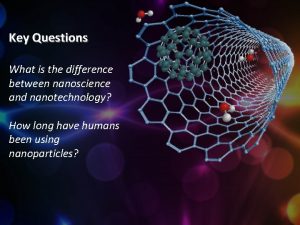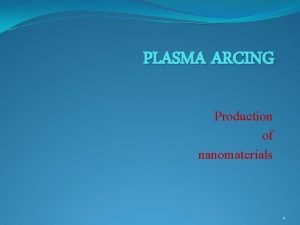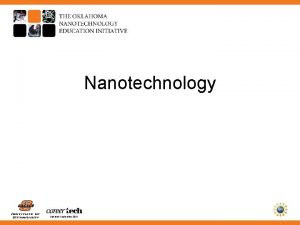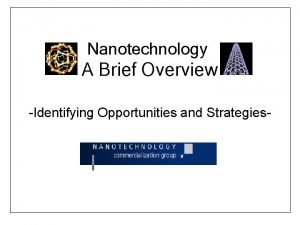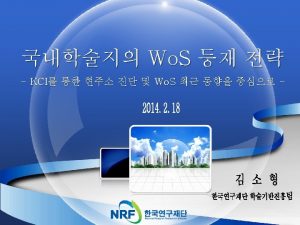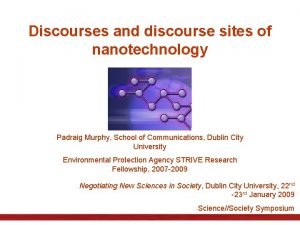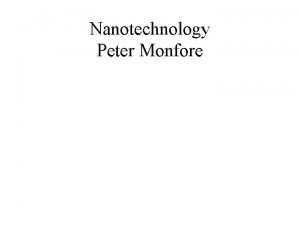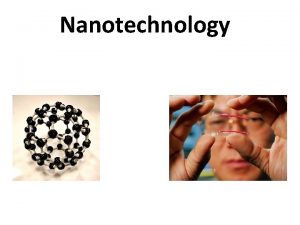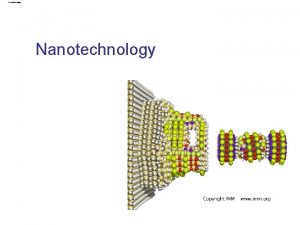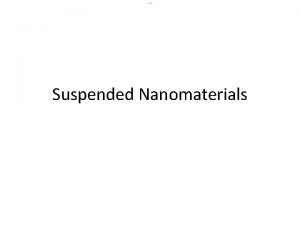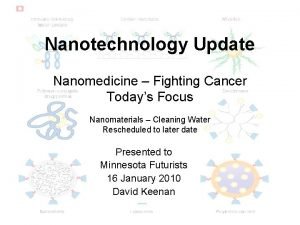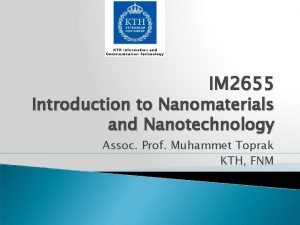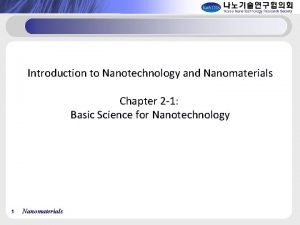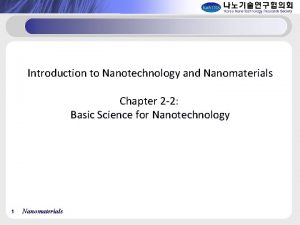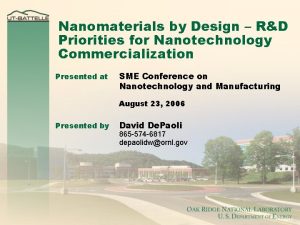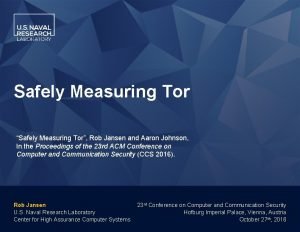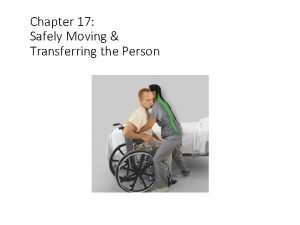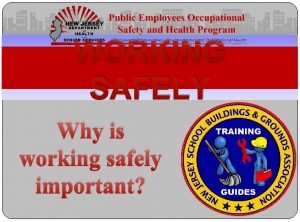Safely Handling Nanomaterials NANOTECHNOLOGY STATE OF THE ART



















- Slides: 19

Safely Handling Nanomaterials “NANOTECHNOLOGY: STATE OF THE ART & APPLICATIONS” San Francisco Bay Area IEEE Nanotechnology Council Sixth Annual Symposium – 18 th and 19 th May, 2010 National Semiconductor Conference Center Walt Trybula, Ph. D. , IEEE Fellow, SPIE Fellow Texas State University & Trybula Foundation, Inc. W. TRYBULA@NANO-SAFETY. INFO

SAFELY HANDLING NANOMATERIALS This lamp, which has micro amounts of Mercury, has EPA handling procedures. Do procedures exist for nanomaterials?

SAFELY HANDLING NANOMATERIALS 1. The entire process is more than just “safety” and we are starting to develop the elements for understanding the precautions 2. We do not know a lot about safety, but we are learning 3. There are some steps that we can take to ensure we are proactive

CONCERNS 1 • Discussions of nanotechnology and safety opens up two traps: • Definitions • Generalities • Current understanding of nanomaterial risks has more holes than a Swiss cheese. • Engineered nanomaterials are accomplished shape-shifters. • People and the environment matter. Remember Nanotechnology is safety-neutral! 1 Adapted from “Ten things everyone should know about nanotechnology safety” by Andrew Maynard, http: //community. safenano. org/blogs/andrew_maynard/archive/2009/08/31/ten-things-everyone-should-know-about-nanotechnology-safety. aspx

Industry Developing Nanoengineered Goods Frustrated by Regulators' Lack of Definitions Manufacturers of nanoengineered products are getting frustrated by the uncertainties about the regulatory definitions of chemicals, materials, and products made with nanotechnologies. The U. S. Environmental Protection Agency's Office of Pesticide Programs (OPP) has come out with its definition of a "nanoscale material": "an ingredient that contains particles that have been intentionally produced to have at least one dimension that measures between approximately 1 and 100 nanometers, " along with a new policy stating that an active or inert ingredient will be considered new if it is nanoscale. But the size-based focus of that definition is different from the one used by the EPA's Office of Pollution Prevention and Toxics (OPPT), which says size alone does not determine whether or not a chemical is new, and therefore subject to review under the Toxic Substances Control Act (TSCA). From Meridian Institute Nanotechnology Portal on Tuesday, May 18, 2010 http: //www. merid. org/NDN/ W. TRYBULA@NANO-SAFETY. INFO

SAFELY HANDLING NANOMATERIALS THE BIG PICTURE

SAFETY OVERVIEW • The concern about safety in handling novel materials focuses on the unknown issues. • Not knowing the impact on people or the environment can lead to unfounded concerns and reluctance to accept developments. • There are four key categories that define NANO-SAFETY and need to be addressed to approach the potential issues in a systematic manner.

NANO-SAFETY KEY CATEGORIES 1. Nanomaterial Properties 2. Impact on People and the Environment • Nano-Health 3. Training & Handling of Nanomaterials • Nanotechnology Safety 4. Business Focus • • Nanotechnology Safety Nanotechnology Risk Management

#1 NANOMATERIAL PROPERTIES • Theoretical and experimental results indicate surprising findings • 13 atoms of Ag has a magnetic moment [Theory] • 13 atoms of Pt have shown a magnetic moment [Experiment] • Materials in nano realm are unique and different • Transition metal in five different states: as hydrated atom; metal complexed in a small protein; metal adsorbed to surface on 1 nm mineral particle; metal adsorbed to surface of 20 nm particle; the same except to a 200 nm particle. 1 • Crystal orientation preferences – size matters • Ce. O 2 < 10 nm habit of truncated octahedron with {100} and {111} faces. Ce. O 2 > 10 nm shifts toward {111} octahedron. 2 • We really don’t know all the possibilities 1 - Hochella, Michael F. Jr. . Nanogeoscience: From Origins to Cutting Edge Applications. December 2008 issue. Vol. 4, pp. 373 -379. 2 - Waychunas, Glenn A. , Hengzhong Zhang. Structure, Chemistry, and Properties of Mineral Nanoparticles. December 2008 issue. Elements. Vol. 4, pp 381 -387.

KNOWN MATERIAL PROPERTIES? Melting point of Gold Magnetic Materials – 13 atoms Known Properties Safety? Silver properties reported May 30, 2006 in Nano. Tech. Web. Platinum experiments reported by University of Stuttgart. • Why are there difference from bulk? • Is part of the reason the percentage of surface atoms? W. TRYBULA@NANO-SAFETY. INFO

#2 PEOPLE &ENVIRONMENT • Toxicity investigations have been of significant interest [many call this Nano-Safety] • Promising medical advances being developed employ Nanomaterials • Impact of these materials on people and the environment needs a lot of evaluation • Beneficial materials, like Ag below 20 nm aids in wound healing by attacking bacteria thus preventing infections, but the same silver particles will also attack good bacteria if the material is not controlled.

#3 TRAINING &HANDLING • The handling of Nanomaterials is a challenge due to the unknowns involved • How do you protect people from materials with properties that are unknown? • If there is a known impact, does it arise from only one part of the material distribution? • Doing nothing is not acceptable • Education guidance and handling procedures must be developed • Key elements must be disseminated

#4 BUSINESS FOCUS • With Unknowns, we must be proactive • Not looking for ISSUES is asking for litigation • Developing future products must consider any potential impact on people and environment • Organizations must have plans in place to address contingencies • Safety efforts are required • Educational programs must be developed

SAFELY HANDLING NANOMATERIALS WHAT SHOULD WE DO?

ISSUES AND DANGERS • • • Toxicity Issues Chemical Dangers Fire Explosion Dust Electrostatic • Size • < 8 nm, 8 to 20 nm, >20 nm • Shape • Straight • Curved • Volume • Density • Concentration

WHERE TO FROM HERE? • With unknowns, we must be proactive • In many cases, we don’t know what we are looking for! • Then the question is: “How do we proceed? ” • While we don’t have all the answers, we can take a number of precautions • The focus of our actions must be to: • • • Keep yourself safe Keep your colleagues safe Keep the general populace safe Keep the facilities safe Keep the environment safe

WHAT ARE WE DOING? • NANO-SAFETY Info site • Centers of NANO-SAFETY • Educational efforts at two- and four-year schools • Institute of NANO-SAFETY [in development] • Partnership focusing on investigating critical areas and developing procedures • NANO-SAFETY Alliance [in planning] • Source for information dissemination to the general public • NANO-SAFETY Portal [in planning] • Providing links to reputable suppliers in areas related to NANO -SAFETY

SUMMARY • There is more to safely handling nanomaterials than going to a non-existent web site to obtain information. This entire field is a work-in-progress • Our current knowledge base provides directions but not absolutes • Implementing proactive procedures provides a measure of developing a possible program Existing sources of information include: http: //www. goodnanoguide. com/ W. TRYBULA@NANO-SAFETY. INFO http: //icon. rice. edu/virtualjournal. cfm

CONTACT INFORMATION Walt Trybula, Ph. D. , IEEE Fellow, SPIE Fellow Texas State University-San Marcos Trybula Foundation, Inc. , Austin, Texas E-mail: w. trybula@nano-safety. info Mobile #: +1. 512. 695. 4026 NANO-SAFETY. info Web site: http: //www. nano-safety. info
 Nanoparticles definition
Nanoparticles definition Mechanical properties of nano materials
Mechanical properties of nano materials Magnetic properties of nanomaterials
Magnetic properties of nanomaterials Timeline of nanotechnology
Timeline of nanotechnology What is nanotechnology
What is nanotechnology Nanotechnology for kids
Nanotechnology for kids Nanotechnology in golf
Nanotechnology in golf Nanotechnology fact or myth
Nanotechnology fact or myth Disadvantage of nanotechnology
Disadvantage of nanotechnology Disadvantage of nanotechnology
Disadvantage of nanotechnology Nanotechnology
Nanotechnology What is nanotechnology
What is nanotechnology Difference between nanoscience and nanotechnology
Difference between nanoscience and nanotechnology Conclusion of nanotechnology
Conclusion of nanotechnology Interpretations of moore's law assert that
Interpretations of moore's law assert that Plasma arcing method
Plasma arcing method Nanotechnology definition
Nanotechnology definition What is nanotechnology
What is nanotechnology Journal of nanoscience and nanotechnology sci
Journal of nanoscience and nanotechnology sci Nanotechnology
Nanotechnology
